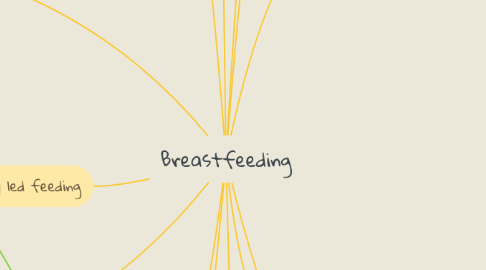
1. Effective positioning and attachment
1.1. How to effectively attach your baby
1.1.1. C - Chin leading towards breast and indent the breast when attached
1.1.2. H - Hold them close for oxytocin release to allow the let down reflex of milk
1.1.3. I - Have the baby inline with your body - horizontal and tummy to tummy
1.1.4. N - Nose to nipple. This is help this baby to open their mouth wide.
1.2. How to recognise effective attachment
1.2.1. Chin indenting the breast
1.2.2. More areola above the baby's mouth than below
1.2.3. Nipple is not flattened when the baby comes off the breast
1.2.4. Nappy colour changing on day 2/3
1.2.5. Baby has a large mouthful of breast
1.2.6. Baby's cheeks remain rounded during suckling an is sucking rhythmically
1.2.7. The baby comes off the breast and finished on their own accord
2. Benefits of Breastfeeding
2.1. Benefits for MUM: Health benefits for Mum: •Reduces the risk of breast and ovarian cancer •Reduces stress •Prevents postpartum depression •Reduces the risk of obesity
2.2. Benefits for Baby: •Reduces the risk of diarrhoea and chest infections •Reduces the risk of obesity and diabetes •Reduces the risk of sudden infant death syndrome •Reduces the risk of developing allergies
3. Informed Choice: Mothers should be given all of the evidence based information available ensuring that it is not biased. This information should facilitate them to make a decision on how they would like to feed their baby
4. 'Avoid making assumptions and recognise diversity and individual choice' (NMC The Code, 2015)
5. Baby led feeding
5.1. signs of a hungry baby:
5.2. -rooting
5.3. -hands to mouth
5.4. -restless
5.5. -smacking or licking lips
5.6. -opening mouth
5.7. -crying
6. Supply and Demand
6.1. baby suckles to release prolactin- the more baby feeds, the more milk is produced
6.2. baby suckles to release oxytocin - causes the myoepithelial cells to expel milk.
6.3. prolactin levels are higher at night so baby led responsive feeding is important in establishing and maintaining milk supply.
7. Expressing
7.1. Hand Expressing
7.1.1. Step 1 - Make a 'C' shape with your fingers around the edge of the areola away from the nipple. Step 2 - Gentle press both fingers together, release and repeat Step 3 - When the milk starts to slow, reposition both fingers and express another area around the nipple.
7.2. Storage
7.2.1. Breast milk can be stored in a fridge below 10C for 3 days.
7.2.2. Breast milk can be stored in a fridge between 0-4c between 4 and 8c
7.2.3. Breast milk can be stored for longer than 8 days if it is frozen.
8. Consequences of not Breastfeeding
8.1. Short Term
8.1.1. Increased incidence of infectious morbidity such as pneumonia and gastroenteritis
8.1.2. Sleepy and lethargic baby
8.1.3. Increased risk of Sudden Infant Death Syndrome (SIDS)
8.2. Long Term
8.2.1. Increased of developing Type 1 or Type 2 diabetes
8.2.2. Increased risk of developing obesity
8.2.3. Increased risk of Leukemia
9. Individualised care pathway
9.1. Carry out a feeding assessment to ensure mothers needs are met.
9.2. Being able to adapt a management plan in accordance to mother and baby's needs
10. Importance of the baby rooming in
10.1. Oxytocin
10.1.1. Oxytocin is needed for the let down of milk. It is important to spend time with your baby to produce the oxytocin so the baby has a sufficient milk supply.
10.2. Skin to skin
10.2.1. This is important as the nipple has the same smell as the amniotic fluid which encourages the baby to feed.
10.2.2. Helps cognitive development and a secure attachment
11. Complications of breastfeeding
11.1. Mastitis
11.1.1. Red inflamed area that is sore to touch
11.1.1.1. Ways to prevent mastitis
11.1.1.2. Effective positioning and attachment
11.1.1.3. Allow the baby to finish the feed at their own accord
11.1.1.4. Avoid using nipple shields
11.1.1.5. Frequent feeding
11.1.1.6. Expressing with breasts are feeling engorged
11.1.1.7. Not wear tight clothing around breasts
11.1.2. Occurs due to milk not being sufficiently removed from the breast
11.2. Thrsuh
11.2.1. Symptoms
11.2.1.1. Mothers nipple are often red and shiny
11.2.1.2. Pain that lasts long after the feed has finished
11.2.1.3. Baby often has a white tongue
11.2.2. Treatment
11.2.2.1. Mother and baby must be treated with anti-fungal medication
11.2.2.2. To prevent reoccurrence - wash clothes on high temperature to kill fungus
11.3. Low milk supply
11.3.1. Often due to lack of support with breastfeeding and poor positioning and attachment
11.3.2. To prevent - ensure good attachment is taught after birth and do not top up the baby with formula unnecessarily.
12. Other roles in helping women to successfully breastfeed
12.1. lactation consultant
12.2. maternity support workers/maternity care assisstants
12.3. peer support networks such as
12.3.1. breastfeeding support workers
12.3.2. local support groups
12.3.3. these are valuable resources for women to seek support. They are separate from healthcare professionals and provide valuable first hand experiences and knowledge.

